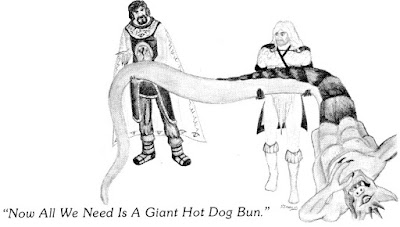 |
| Art by Tracy Cameron Mansfield; “Humor” by ? |
As mentioned last week, there is no setting description in Wizards' World. Yet there are clues to the flavor and tone of the campaign(s) from which the game developed. Humor – or what could charitably be described as such – is in evidence. For instance, the game's section on coins makes reference to “quatloos,” a thousand of which equal the value of a copper piece. The descriptions of original creatures tend to offer the most insight into the Wizards' World 'playtest' environment.
All Wizards' World creatures have a 'profession' (or more than one profession) and a range of 'levels' to represent their ability. For example, weasels are thieves of first or second level; war horses are warriors of second through fifth level. A creature's experience value is determined by its level; specifically, “the sum of the squares of its levels times 100.” So, an amethyst dragon having two warrior levels and two wizard levels is worth 800 experience points.
“Humor” also appears in the creature descriptions. For instance, “Valley Giants are often seen wandering about saying things like 'bitchin´ to the max' and 'like, totally'.” (Valley Giants are “jesters” of ninth to sixteenth level.) Also, “Rhasti are similar in appearance to weasels...[they] are peculiar in that no matter what language they use, and even if they communicate telepathically, they have a British accent.” Additionally, “A place guarded by a troll that will accept bribes is often call [sic] a 'troll booth'.”
Wizards' World includes some standard fantasy standards like orcs (first to second level warriors), werewolves (sixth through ninth level attackers), and succubi (third though ninth level wizards / second level black knights). There are also recognizable creatures with new names and cosmetic changes: azara (second to fifth level warriors) are “like lions, except they are dark blue in colour,” rogoroth (sixth to ninth level attackers) are giant eagles, and zilman (first through third level warriors) are effectively D&D troglodytes.
Here are some odd creatures original to Wizards' World:
Krang “appear as men, except their clothing is lighter.” They are warriors of sixth through fifteenth level and can teleport anywhere at will.
Yaka “closely resemble rabbits” but have the “ability to possess others.” They have one to three levels as wizards and one to three levels as spies. If a yaka successfully possesses a player character, it “will have the unfortunate player [sic] attack his own party” for the ultimate purpose of acquiring the party's treasure. Possession only lasts for a number of minutes but, evidently, “they retain all knowledge that the victim had.” Yaka have an intelligence range of 16 - 20, in excess of the 'normal' intelligence level of the player character races. Would such entities be satisfied with treasure? What use do they have for it?
Wolverenes are wolverines that can “fire a bolt of electricity from their bodies.”
“Tasnics seem to have no aim in life other than to have fun and collect treasure.” They are wizards of second through nineteenth level and – even though they “can transform into humanoid form at will” – tasnics usually appear as “furry winged serpents.” Among their special abilities, tasnics have “eye beams” and can “view reality.”
“Epsilons are bull-like creatures with red horns and eyes and black fur.” They “can fire green colored bolts of energy that inflict...damage and cause paralyzation.”
Vexaxaxi (sing. vexaxax) “look like green gorillas with tusks.” They have eight to twelve levels as attackers and nine to sixteen levels as assassins. “They are supremely designed to deal out death.” Not only do “vexaxaxi have retractable fangs that hold...poison,” they “can fire a death bolt from a single horn growing out the back of their skulls.”

No comments:
Post a Comment